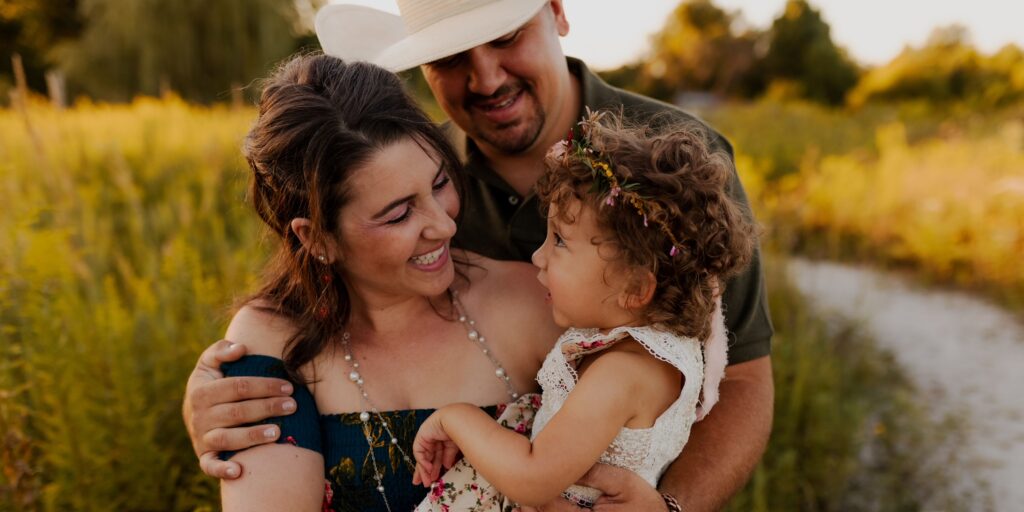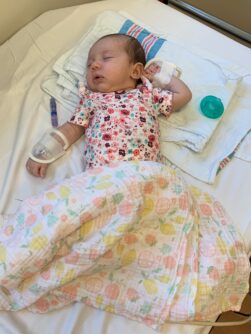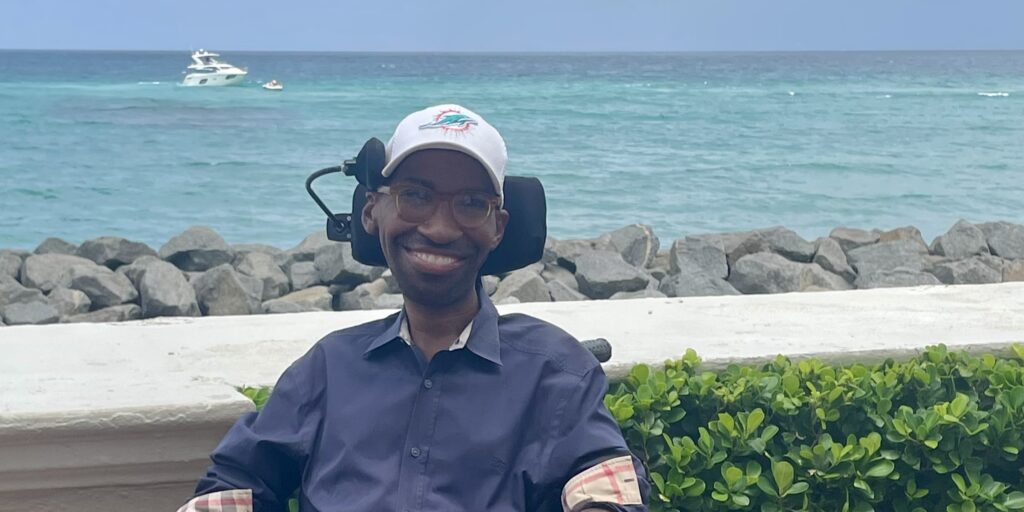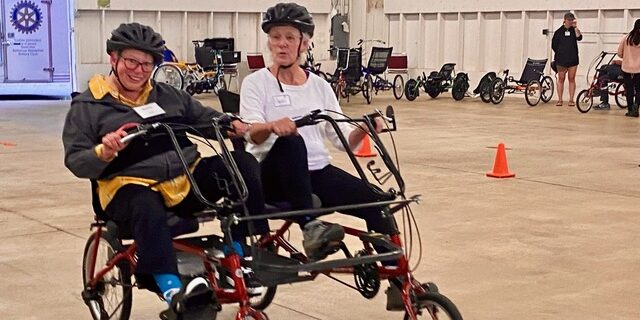
My Gene Therapy Journey: The Graves Family
By Rebecca Hume | Wednesday, August 7, 2024
5 Second Summary
Gene therapies are increasingly available for muscular dystrophies and other neuromuscular diseases. My Gene Therapy Journey is a Quest Media series that gives members of the neuromuscular community a platform to share their experiences with gene therapies — both approved therapies and those in clinical trials — and provides essential information to help individuals and families make decisions about gene therapies.

Kody Graves and Sydney Knobel-Graves
When Sydney Knobel-Graves and Kody Graves became first-time parents in July of 2019, they quickly realized that the timing of their daughter Kenzie’s birth would play a critical role in the shape of their family’s future. At her one-week appointment, doctors confirmed that Kenzie’s newborn screening test revealed a spinal muscular atrophy (SMA) Type 1 diagnosis, a rare neuromuscular disease that had only just recently been added to the screening panel. The early diagnosis enabled Kenzie’s medical team to act quickly, outlining treatment options that included the brand-new gene therapy treatment Zolgensma. Kenzie would become the 5th infant in the nation, and the 2nd in the state of Missouri, to receive gene therapy for SMA.
Gathering information and making an important decision
Kenzie’s parents were made aware of the screening results as they were being discharged from the maternity ward on a Friday afternoon but did not have any information on the disease or treatment options. It wasn’t until they returned to their pediatrician that following Monday for Kenzie’s one-week appointment that they were able to learn more about her diagnosis. After meeting with the pediatrician, the Graves were told that they would also be seeing a neurologist that same day. They met with Dr. Craig Zaidman a neurologist who specializes in neuromuscular disease at the St. Louis Children’s/Washington University Hospital’s MDA Care Center.
“I knew nothing about SMA until we were sitting in the doctor’s office basically the same day that she was officially diagnosed by a specialist,” Sydney recalls. “Our neurologist outlined treatment options at that same appointment, which at the time included Zolgensma and Spinraza. He drew on the back of a paper the mechanisms of each treatment and the intended outcomes. At that time, Zolgensma had only been commercially approved for a few weeks.”

Kenzie Graves as a newborn
As the new parents attempted to process their daughter’s diagnosis, they were also tasked with making an important decision for her care. Their neurologist shared the expected progression of SMA without treatment and explained that Kenzie’s muscles would atrophy over time, but also offered hope through new treatments. At the time, it was not clear if Kenzie would be able to receive both treatments so they needed to choose which one they thought would be best for her.
“It was definitely an emotional rollercoaster,” Sydney says. “You know, there is a side of it where you are dealing with the shock of ‘oh my gosh, our child just came into the world and has this disease’ – but also okay, there is something that we could potentially do about it. It was a lot of battling with knowing that there is no guarantee of outcome but also knowing that you have to treat it. The hope part sinks in a little later, but at the moment you feel like you have some control back because you are making a decision for your child.”
After discussing options, Sydney and Kody decided that pursuing Zolgensma would be the best course of action to hopefully slow the progression of Kenzie’s disease and to extend her life. “We chose gene therapy even though it was newer because it is so much less intensive (than Spinraza) and there was a lot of confidence in the Zolgensma trials,” Kody says. “Our doctor really laid it out and he had faith in gene therapy making a difference for her. And to know that the FDA fast tracked approval meant a lot to us.”
Pursuing approvals for progressive treatment
The Graves initially attempted to have Kenzie accepted into a trial for Zolgensma that they had learned was about to start. Because the treatment was so new and insurance approval was unknown territory, they felt that the trial would be the fastest way to access care. This plan was thrown off course when her bloodwork showed what would later be revealed to be a false positive for a metabolic disease, excluding her from eligibility. Not wanting to delay treatment, Sydney and Kody decided that Spinraza would the best option because Kenzie could have quick access. They opted to take the risk that she might not be eligible for gene therapy if insurance would only approve one treatment. However, specialists were unable to get a spinal tap to administer Spinraza because Kenzie was so small. Having never previously experienced a challenge completing the spinal tap, the team even used a special imaging device to help navigate but they were still unable to complete the procedure. As their course of action changed again, Kenzie’s medical team began aggressively pursuing insurance approval for gene therapy.

Kody and Kenzie on infusion day
“We were very lucky with our medical office,” Sydney says. “Because they were aggressive in pursuing treatment and very pushy, in a good way, with the urgency of getting her treated. They were really the direct connect between us and the insurance company – which is not always the case. We had a lot of communication with our office coordinator, and I know she pushed for approval as an urgent life-or-death scenario. She spent a lot of time on the phone with the insurance company about why it was critical to approve and process immediately.”
“Our insurance coordinator was fantastic,” Kody says. “I think it was all so relatively new and there wasn’t really an insurance company process for this yet – but we were able to get approval in less than two weeks. We actually had another Spinraza appointment and were going to try again for a spinal tap because we hadn’t heard back from insurance, and the night before that appointment we found out that she was approved. So, we went in the next morning for gene therapy instead of Spinraza.”
Planning and accessing care
The Graves recognize what a significant role timing has played in their ability to access care for Kenzie. In addition to the significance of a life-altering gene therapy being approved just months before Kenzie’s birth, Sydney and Kody feel fortunate to have received newborn screening for SMA and for giving birth near an an MDA Care Center. By luck and proximity, they were immediately connected with neuromuscular disease experts and able to address Kenzie’s diagnosis in the first few weeks of her life.
“Even with her diagnosis, the neurologists received her bloodwork from the newborn screening on a Friday night,” Kody says. “And being an MDA Care Center and having done a lot of Zolgensma testing, they saw the request for an SMA confirmation come through and were like, ‘we have to do this right now.’ With this disease, it’s all about timing – and all of the timing has been nothing short of miraculous.”

Kenzie as a toddler
Without newborn screening, access to experts in the SMA treatment landscape, and the timely approval of gene therapy treatment, Kenzie’s prognosis could have been very different. Kenzie received her Zolgensma infusion at four weeks old. Specialists placed a large intravenous catheter attached to a pump that slowly infused the therapy over the course of an hour and a half. Kody laid with Kenzie to help keep her still, and they both slept through the procedure.
Looking to the future
At 15 months old, Kenzie also started receiving Evrysdi, an additional SMA treatment that had been recently approved at that time. The now five-year-old calls it her “go-go juice”. While her parents were uncertain what to expect from both treatments, they share that they are certain her disease would have progressed more without access to care.
“We knew the treatments had been successful, but we initially had no idea if she would walk. We really never knew what her ceiling would be and there was no expectation set for that,” Sydney shares. “I have seen kids around her age that were treated at 2 weeks that need more support than her and there are kids treated at her age that have fewer symptoms than her – so it’s hard to tell where she would have been without treatment. But we know she wouldn’t be where she is today.”

Kenzie at her pre-K graduation
Kenzie eventually started crawling and walking at 21 months old. Today, she is an active, sweet, and silly child who loves playing and spending time with her family and friends. While she isn’t able to run or jump the same as her peers, she otherwise shows few notable signs of limitations. Her muscles need more rest than other children and she uses a wheelchair when traveling far distances or when she needs to rest to prevent over-exertion. Part of her IEP at school includes learning to manage and monitor her own energy levels. Her parents introduced a manual wheelchair recently to acclimate Kenzie with using the mobility device independently, both to allow muscle breaks and so that if her needs increase in the future she will be prepared.
“She is very go-go-go,” Kody says. “Sometimes when she gets home from school you can tell that she is tired from walking and playing all day. But if she wants to keep playing, she will use her wheelchair and zoom around the house. It allows her to keep doing what she wants to do without exerting more energy.”
Advice for other families
Sydney and Kody advise other families who may be considering the treatment to take advantage of the resources that are now available on their gene therapy journey. The Graves have recently connected with other families through the MDA Gene Therapy Network’s support group, where they share their experience and are able to offer and receive guidance. The connection provides a forum to ask questions and learn about other families’ experiences.

Kenzie walking with her parents
Gene therapy has provided hope for Kenzie’s future, a hope that motivates the Graves to recommend the treatment to others. “I would advise other parents to choose to treat as immediately as possible,” Sydney says. “I have heard that there is an interesting fear of gene therapies for different reasons and sometimes there are parents that think it is not natural. It’s hard for me to identify with that because I am a scientist, but I would say, the reality is that natural in this scenario is not necessarily better. Because “natural” means a decrease over time. And there is no other treatment out there that gives you back the gene you are missing – that is pretty monumental. And you are treating the source of the issue.”
For the Graves, making the decision for Kenzie to receive gene therapy is a decision that they wholeheartedly believe was worth it. “When you look at the fact that she is five years old, she is alive, and she is a relatively average functioning kid versus where she might be if we hadn’t done treatment,” Kody says. “I would make the decision over again every day for one hundred years.”
Next Steps and Useful Resources
- Learn more about current SMA treatments.
- MDA’s Gene Therapy Support Network connects you to information, resources, and one-on-one support.
- Get the basics in MDA’s Virtual Learning webinar Gene Therapy 101.
- Watch a video about how MDA has led the wayin gene therapy development research.
- Stay up-to-date on Quest content! Subscribe to Quest Magazine and Newsletter.
TAGS: Gene Therapy, Healthcare, MDA Care Centers, My Gene Therapy Journey, Newborn Screening, Parenting
TYPE: Blog Post
Disclaimer: No content on this site should ever be used as a substitute for direct medical advice from your doctor or other qualified clinician.




